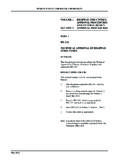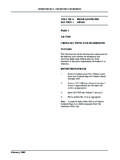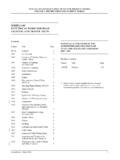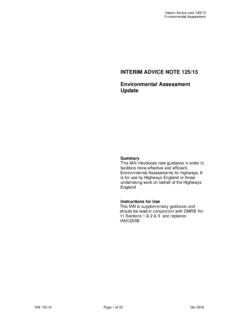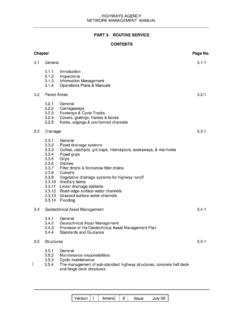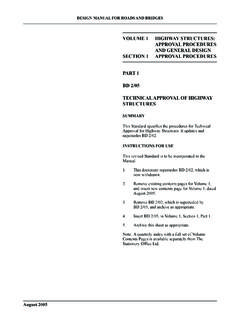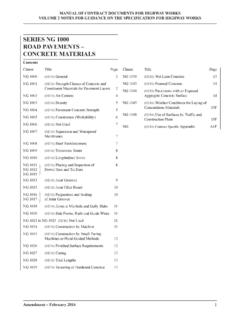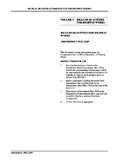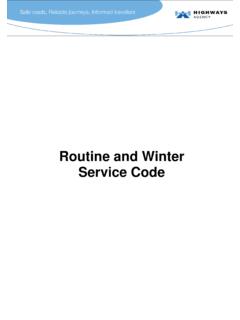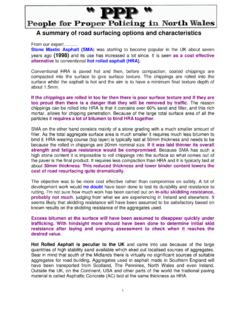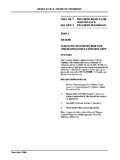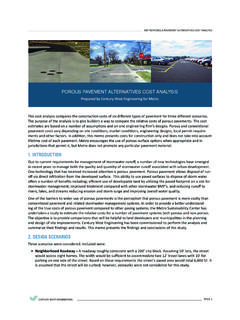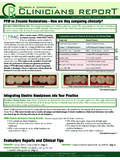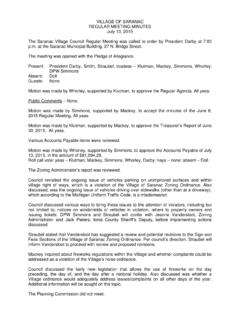Transcription of VOLUME 7 PAVEMENT DESIGN AND …
1 DESIGN MANUAL FOR ROADS AND BRIDGES HD32/16 February 2016 VOLUME 7 PAVEMENT DESIGN AND MAINTENANCESECTION 4 PAVEMENT maintenance METHODSPART 2HD 32/16 maintenance OF CONCRETE ROADSSUMMARYThe purpose of this document is to describe how to maintain exposed concrete road pavements including the repair of structural damage and refurbishment of worn running surfaces on the UK strategic road FOR USE1. This document supersedes HD 32/94 which is now Remove existing contents page for VOLUME 7 and insert new contents page for VOLUME 7 dated February Remove HD 32/94 and archive as Insert HD 32/16 in to VOLUME 7, section 4, Part Archive this sheet as : A quarterly index with a full set of VOLUME Contents Pages is available separately from The Stationery Office MANUAL FOR ROADS AND BRIDGES HD32/16 maintenance of Concrete RoadsSUMMARYThe purpose of this document is to describe how to maintain exposed concrete road pavements including the repair of structural damage and refurbishment of worn running surfaces on the UK strategic road ENGLANDTRANSPORT SCOTLANDWELSH GOVERNMENTLLYWODRAETH CYMRUTHE DEPARTMENT FOR REGIONAL DEVELOPMENTNORTHERN IRELANDHD 32/16 VOLUME 7, section 4,Part 2 DESIGN MANUAL FOR ROADS AND BRIDGES HD32/16 February 2016 VOLUME 7 PAVEMENT DESIGN AND MAINTENANCESECTION 4 PAVEMENT maintenance METHODSPART 2HD 32/16 maintenance OF CONCRETE ROADSC ontentsChapter1.
2 Introduction2. Deciding on Treatment Type3. Surface Treatment Products and Systems4. Joint Repairs5. Full depth structural repairs and reinstatements6. Strengthening7. References8. Enquiries9. NotificationDESIGN MANUAL FOR ROADS AND BRIDGESF ebruary 2016 February 20161/1 Chapter 1 VOLUME 7 section 4 Part 2 HD 32/161. Proper maintenance of pavements is important if the structure is to have a reasonable expectancy of remaining in a satisfactory condition and achieving the designed service life. To assess the need for maintenance and repair work a standard procedure of regular inspection and fault recording is necessary, as described in HD 29 (DMRB ) and HD 30 (DMRB ). This should ensure correct diagnosis of the various types of defect that may be This part of the DMRB gives recommendations for maintenance , repair and structural strengthening of layers of concrete and hydraulically bound mixtures in pavements based on current experience using products and technologies which are tried and proven.
3 Allowance has also been made for innovation, with alternative products and technologies encouraged for consideration. The latest advice should be sought from the Overseeing Organisation if alternative products and technologies are to be Procedures for maintenance and repair are given in Annex 1 of this document and reference shall also be made to the Specification (MCHW). For more general information on the maintenance and repair of concrete roads reference can be made to the Manual for maintenance and Repair of Concrete For the purpose of minor repairs, surface treatments, and major strengthening works; pavements with equal to or greater than 50 mm of bituminous surfacing over concrete and/or hydraulically bound mixtures should be treated in accordance with HD 30 (DMRB ) and HD 31 (DMRB ). The requirements and guidance on this document are given on the basis that the maintenance of concrete roads will be carried out using the Specification for Highway Works (MCHW ).
4 However, products conforming to equivalent standards and specifications of other member states of the European Union and tests undertaken in other member states may be acceptable in accordance with the terms of the 104 and 105 Series of Clauses of that Any reference in this specification to a British Standard , or to a British Standard which is an adopted European Standard , is to be taken to include reference also to the following standards:a) a standard or code of practice of a national standards body or equivalent body of any EEA state or Turkey;b) any international standard recognised for use as a standard or code of practice by any EEA state or Turkey;c) a technical specification recognised for use as a standard by a public authority of any EEA state or Turkey; andd) a European Technical Approval (ETA) issued in accordance with the procedure set out in directive 89/106 there is a requirement in this specification for compliance with any part of a British Standard or a British Standard which is an adopted European Standard, that requirement may be met by compliance with any of the standards given above, provided that the relevant standard imposes an equivalent level of performance and safety provided for by a British Standard or a British Standard which is an adopted European 2016 Chapter 1 VOLUME 7 section 4 Part 2 HD 32/16 EEA State means a state which is a contracting party to the EEA Agreement.
5 EEA Agreement means the agreement on a European Economic Area signed at Oporto on the 2nd of May 1992 as adjusted or This Part shall be used forthwith on all schemes for the improvement and maintenance of trunk roads including motorways, currently being prepared provided that, in the opinion of the Overseeing Organisation this would not result in significant additional expense or delay. DESIGN organisations should confirm its application to particular schemes with the Overseeing 20162/1 Chapter 2 VOLUME 7 section 4 Part 2 HD 32/162. DECIDING ON TREATMENT TYPESCOPE OF There are several different types of pavements incorporating concrete and/or hydraulically bound mixtures. The appropriate treatments will vary according to type of PAVEMENT and defect. Those types of PAVEMENT incorporating concrete and/or hydraulically bound mixtures most commonly encountered are: CRCP Continuously reinforced concrete PAVEMENT CRCB Continuously reinforced concrete base JRC Jointed reinforced concrete PAVEMENT JUC Jointed unreinforced concrete PAVEMENT Thinly overlaid concrete pavements and/or hydraulically bound materials with less than 50 mm thick flexible surfacing For the purpose of minor repairs, surface treatments, and major strengthening works; maintenance of the pavements types detailed in section will be undertaken in accordance with this document HD32 (DMRB ).
6 Structural deterioration mechanisms in flexible pavements are very different to those in rigid pavements and pavements with hydraulically bound base layers. Therefore, pavements with equal to or greater than 50 mm of bituminous surfacing are outside of the scope of HD32 (DMRB ) and shall be treated in accordance with HD 30 (DMRB ) and HD 31 (DMRB ). maintenance The maintenance assessment procedure for the types of pavements described in section , shall have been carried out in accordance with HD 30 (DMRB ). The Network survey data sets need to be collected and reviewed following the route of assessment of treatment for rigid PAVEMENT and pavements with hydraulically bound base layers. The following section describes the major and minor AND MINOR Distress in the types of PAVEMENT described in section is evident by the following defects, identified using PAVEMENT conditions data sets:Major DefectsProvision of skid resistance below investigatory level with related accident history as detailed in HD 28 (DMRB ) Rocking slabs Stepping (transverse and longitudinal) Pumping Longitudinal Cracking2/2 February 2016 Chapter 2 VOLUME 7 section 4 Part 2 HD 32/16 Transverse Cracking Deep Spalling (equal to or greater than 10 mm depth) Structural rutting within bituminous surfacing Reflective cracking within bituminous surfacing Corner Cracking (also known as Corner Break) Slab sinking Extensive shallow spalling to a depth less than or equal to 10 mmMinor Defects Joint seal damage/missing Surface scaling Localised shallow spalling to a depth less than or equal to 10 mm Skid resistance below investigatory level without related accidents as detailed in HD 28 (DMRB ) Accident Data where the skid resistance is above the investigatory level as detailed in HD 28 (DMRB )
7 Asphalt surfacing defects such as surface cracking, loss of aggregate due to hardening of the bitumen (fretting) and surface ruttingMAINTENANCE SCHEME AND WORKING The general decision making process for treatment DESIGN is given in HD 30 (DMRB ), including consideration of necessity of treatment and whole life cost. In addition to the PAVEMENT and defect type; the selection PAVEMENT treatment for each scheme will depend on the length of the available working window. Advice should be sought from the Overseeing Organisation as to the whole life cost of treatments and want can be achieved in available working windows. The following section gives specific detail for the types of PAVEMENT described in section OF maintenance Selection of the appropriate maintenance treatment products and systems is dependent on the PAVEMENT type, defect and wider considerations such as safety, serviceability, financial, environmental and traffic disruption considerations.
8 For the types of PAVEMENT described in section , the treatment type associated with defect can broadly be split into: Surface defects ( section 3) Joint defects ( section 4) Structural defects that require strengthening ( section 5) Structural defects that require full depth structural repairs and reinstatement ( section 6)February 20162/3 Chapter 2 VOLUME 7 section 4 Part 2 HD 32 Figure 2 gives an overview of maintenance treatment type for the Major and Minor Defects. Recurrence of defects, assessment management strategy and constraints on working windows need to be considered in the selection of appropriate treatments and further information on overlay treatments for jointed reinforced concrete pavements, jointed unreinforced concrete pavements and thinly overlaid concrete pavements and/or hydraulically bound mixture with less than 50 mm thick flexible surfacing can be found in TRL Report TRL 657 (2006). Structural defects in continuously reinforced concrete pavements and continuously reinforced concrete base are detailed separately in section to general information on maintenance of concrete roads can be found in The Concrete PAVEMENT maintenance Manual.
9 Highways Agency 20012/4 February 2016 Chapter 2 VOLUME 7 section 4 Part 2 HD 32/16 Figure 2 Overview of Defects and maintenance RequirementsFebruary 20163/1 Chapter 3 VOLUME 7 section 4 Part 2 HD 32/163. SURFACE TREATMENT PRODUCTS AND SYSTEMSOVERVIEW OF SURFACE TREATMENT Surface treatment options are primarily used to restore skid resistance. In-service concrete pavements lose surface texture due to both the attrition of the cement mortar matrix and polishing effects of traffic on the exposed aggregate component. Brush finished surfaces are particularly prone to this HD 28 (DMRB ) discusses the assessment of skidding resistance using the sideway-force Coefficient Routine Investigation Machine (SCRIM), PAVEMENT Friction Tester and Portable Pendulum Tester. SCRIM only measures skidding resistance at speeds within a road speed range 30 to 85 km/hr but has a skidding component of 17 to 20 km/hr. The PAVEMENT Friction tester can measure the peak and sliding friction of a road surface at traffic There are several different methods of restoring skidding resistance to concrete roads, and selecting the most suitable depends on the type of road, speed of traffic, and the aggregate used in the concrete.
10 Some methods will restore macrotexture, while others only improve microtexture, and some do both. The following categories of surface treatment products and systems techniques are covered in this section : Bituminous overlay Ultra thin and thin Concrete overlay Transverse grooving Retexturing Surface re-profiling Surface protection products and systemsA general summary of expected service life and other considerations (including tyre/road noise and skid resistance) given in Table Bituminous overlays comprise a range of mixtures and techniques; including: slurry surfacing, surface dressing, cold applied ultra thin surfacing, ultra thin and thin surface course system. These applications range in durability and expected service life (see Table ), with thin surfacing overlays being the standard on the Highway Agency Overlay DESIGN and selection as a technique requires consideration of levels to retain sufficient headroom under over-bridges, to minimise the need to raise kerbs, safety barriers and/or ironwork.
